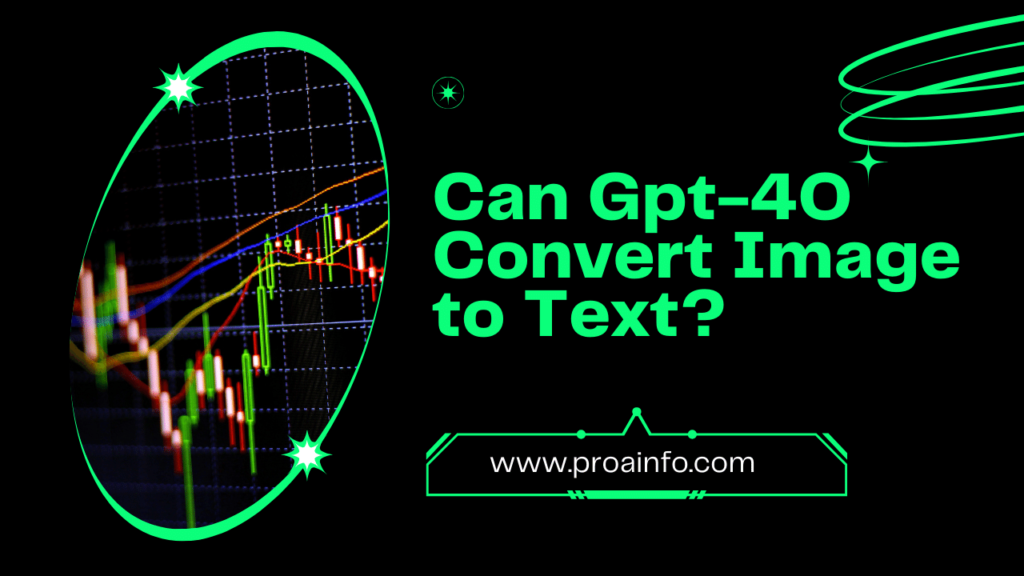Can Gpt-4O Convert Image to Text? In the rapidly evolving field of artificial intelligence (AI), one of the most exciting and transformative developments has been the advent of large language models (LLMs) like GPT-4. Developed by OpenAI, GPT-4 is the latest iteration of the company’s flagship natural language processing (NLP) model, boasting impressive capabilities in understanding and generating human-like text.
As the world becomes increasingly digitized, the ability to seamlessly process and interpret various forms of data, including images, has become increasingly important. One of the intriguing questions surrounding GPT-4 is whether it possesses the capability to convert images into text – a feat that would open up a world of possibilities in fields ranging from accessibility to content creation.
In this comprehensive article, we will delve into the intricacies of GPT-4’s image-to-text conversion capabilities, exploring the underlying technologies, potential applications, and the broader implications of this groundbreaking development.
Understanding GPT-4: A Brief Overview
Before diving into the specifics of image-to-text conversion, it’s essential to understand the fundamental principles behind GPT-4 and its predecessors. GPT, short for Generative Pre-trained Transformer, is a type of language model that utilizes deep learning techniques to understand and generate human-like text.
GPT models are trained on vast amounts of textual data from the internet, allowing them to learn patterns, context, and relationships within language. This training process enables the models to develop an understanding of natural language, which they can then leverage to perform various tasks, such as text generation, summarization, translation, and question answering.
GPT-4, the latest iteration of the GPT series, has been touted as a significant leap forward in terms of capabilities and performance. While the exact details of its architecture and training process remain closely guarded by OpenAI, it is widely believed that GPT-4 incorporates advancements in areas such as multimodal learning, few-shot learning, and unsupervised learning.
Multimodal Learning: The Key to Image-to-Text Conversion
One of the most intriguing aspects of GPT-4 is its purported ability to process and understand multimodal data, which includes not just text but also images, audio, and video. This capability is made possible through a process known as multimodal learning, which involves training the model on various types of data simultaneously.
In the context of image-to-text conversion, multimodal learning allows GPT-4 to analyze visual information and generate corresponding textual descriptions or captions. This process involves extracting relevant features and patterns from the image and mapping them to textual representations that accurately describe the visual content.
The underlying technology behind multimodal learning in GPT-4 is likely to involve a combination of computer vision techniques and language modeling. Computer vision algorithms are used to analyze and extract relevant features from the input image, such as objects, colors, textures, and spatial relationships. These visual features are then fed into the language model, which generates textual descriptions based on its understanding of the input data and the patterns it has learned during training.
Potential Applications of Image-to-Text Conversion
The ability to convert images into text has a wide range of potential applications across various domains, some of which are outlined below:
- Accessibility: Image-to-text conversion can significantly enhance accessibility for individuals with visual impairments. By providing textual descriptions of images, GPT-4 can enable these individuals to better understand and engage with visual content, fostering greater inclusivity and equal access to information.
- Content Creation: In the realm of content creation, image-to-text conversion can streamline the process of generating descriptions, captions, and metadata for visual assets. Writers, bloggers, and social media creators can leverage GPT-4 to generate accurate and engaging textual descriptions for their images, saving time and effort.
- E-commerce and Product Cataloging: Online retailers and e-commerce platforms can benefit from GPT-4’s image-to-text capabilities by automating the creation of product descriptions and metadata. This can improve the discoverability of products and enhance the overall shopping experience for customers.
- Image Archiving and Indexing: Large organizations and institutions that manage vast collections of images, such as museums, libraries, and archives, can utilize GPT-4 to generate textual descriptions and metadata for their visual assets. This can facilitate more efficient searching, indexing, and organization of these collections.
- Visual Question Answering: GPT-4’s multimodal capabilities can potentially enable advanced visual question answering systems, where users can ask questions about specific elements or aspects of an image, and the model can provide accurate textual responses based on its understanding of the visual content.
- Image Captioning for Social Media: Social media platforms heavily rely on visual content, and GPT-4’s image-to-text conversion capabilities can be leveraged to generate accurate and engaging captions for user-shared images automatically. This can enhance the discoverability and engagement of visual content on these platforms.
Challenges and Limitations
While the prospect of GPT-4’s image-to-text conversion capabilities is undoubtedly exciting, it is important to acknowledge the potential challenges and limitations associated with this technology:
- Accuracy and Reliability: One of the primary concerns surrounding image-to-text conversion is the accuracy and reliability of the generated textual descriptions. GPT-4’s performance in this domain will heavily depend on the quality and diversity of the training data, as well as the model’s ability to generalize and interpret complex visual scenes accurately.
- Contextual Understanding: Images often convey nuanced meanings and contexts that may be challenging for AI models to capture fully. GPT-4 will need to demonstrate a deep understanding of contextual cues, cultural references, and subtle visual metaphors to generate truly meaningful and insightful textual descriptions.
- Bias and Ethical Considerations: Like many AI systems, GPT-4 may be susceptible to biases present in its training data or inherent in its architecture. Ensuring fair and ethical representation in the generated textual descriptions will be crucial, especially when dealing with sensitive or potentially harmful content.
- Computational Resources: Processing and analyzing images, particularly high-resolution or complex ones, can be computationally intensive. Deploying GPT-4’s image-to-text conversion capabilities at scale may require significant computational resources, which could pose challenges in terms of cost and accessibility.
- Integration and Interoperability: For GPT-4’s image-to-text conversion capabilities to be widely adopted, seamless integration with existing systems and platforms will be necessary. Ensuring interoperability and compatibility with various image formats, content management systems, and user interfaces will be crucial for successful implementation.
Future Developments and Outlook
Despite the challenges and limitations, the potential of GPT-4’s image-to-text conversion capabilities is undeniable. As the technology continues to evolve and mature, we can expect to see further advancements and refinements in this area:
- Improved Accuracy and Contextual Understanding: With ongoing research and development, GPT-4 and other AI models are likely to become more accurate and reliable in their image-to-text conversion capabilities. Advancements in areas such as few-shot learning, transfer learning, and self-supervised learning may contribute to better contextual understanding and more nuanced textual descriptions.
- Multimodal Integration: While GPT-4 is primarily focused on text and image processing, future iterations of the model or other AI systems may integrate additional modalities, such as audio and video. This could lead to more comprehensive multimodal understanding and the ability to generate textual descriptions that capture the full richness of multimedia content.
- Real-time and Interactive Applications: As computational power and infrastructure improve, we may see the emergence of real-time and interactive image-to-text conversion applications. These could enable users to engage with visual content in a more dynamic and immersive manner, potentially revolutionizing fields like augmented reality, virtual assistants, and human-computer interaction.
- Ethical and Responsible AI Development: As the capabilities of AI models like GPT-4 continue to expand, there will be a heightened emphasis on ethical and responsible development practices. Addressing issues related to bias, privacy, and transparency will be crucial to ensuring that these technologies are deployed in a fair and responsible manner.
- Democratization and Accessibility: With continued advancements and wider adoption, image-to-text conversion technologies like those offered by GPT-4 may become more accessible and democratized. This could empower individuals, small businesses, and organizations to leverage these capabilities, fostering greater inclusivity and innovation across various sectors.
Conclusion
The advent of GPT-4 and its purported ability to convert images into text represents a significant milestone in the field of artificial intelligence. By bridging the gap between visual and textual information, this technology opens up a world of possibilities for enhancing accessibility, streamlining content creation, and enabling more intuitive and engaging human-computer interactions.
While the potential applications of image-to-text conversion are vast and exciting, it is crucial to approach this technology with a critical eye and a strong emphasis on ethical considerations. Addressing issues related to bias, privacy, intellectual property, and transparency will be essential to ensuring that these capabilities are deployed in a responsible and beneficial manner.
As the field of AI continues to evolve at a rapid pace, the successful implementation of GPT-4’s image-to-text conversion capabilities will depend on ongoing research, development, and collaboration among stakeholders from various disciplines. By working together and maintaining a commitment to ethical and responsible AI development, we can harness the power of these transformative technologies while mitigating potential risks and fostering a more inclusive and equitable digital landscape.







